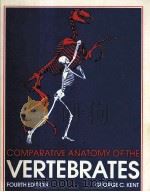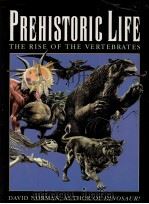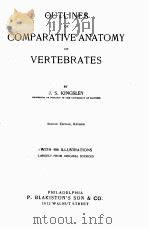《The Life of Vertebrates Second Edition》
| 作者 | J.Z.Young 编者 |
|---|---|
| 出版 | At The Clarendon Press |
| 参考页数 | 820 |
| 出版时间 | 1962(求助前请核对) 目录预览 |
| ISBN号 | 无 — 求助条款 |
| PDF编号 | 818143588(仅供预览,未存储实际文件) |
| 求助格式 | 扫描PDF(若分多册发行,每次仅能受理1册) |

Ⅰ.EVOLUTION OF LIFE IN RELATION TO CLIMATIC AND GEOLOGICAL CHANGE1
1.The need for generality in zoology1
2.What do we mean by the life of an animal?2
3.Living things tend to preserve themselves3
4.What do we mean by awareness of life?5
5.The influence of environment on life7
6.What is it that heredity transmits?8
7.The increasing complexity of life9
8.The progression of life from the water to more difficult environments9
9.Changes of climate and geological periods11
(1)Changes of level of the continents11
(2) Changes of climate13
(3) Geological time16
(4) Classification of geological history18
10.Summary21
Ⅱ.THE GENERAL PLAN OF CHORDATE ORGANIZATION:AMPHIOXUS23
1.The variety of chordate life23
2.Classification of chordates24
3.Amphioxus,a generalized chordate24
4.Movement of amphioxus26
5.Skeletal structures of amphioxus29
6.Skin of amphioxus29
7.Mouth and pharynx and the control of feeding30
8.Circulation33
9.Excretory system of amphioxus35
10.Nervous system36
11.Gonads and development of amphioxus41
12.Amphioxus as a generalized chordate46
Ⅲ.THE ORIGIN OF CHORDATES FROM FILTER FEEDING ANIMALS47
1.Invertebrate relatives of the chordates47
2.Subphylum Hemichordata (= Stomochordata)50
3.Class Pterobranchia58
4.Subphylum Tunicata.Sea squirts60
5.Development of ascidians66
6.Various forms of tunicate69
7.Class Ascidiacea.70
8.Class Thaliacea70
9.Class Larvacea72
10.The formation of the chordates74
Ⅳ.THE VERTEBRATES WITHOUT JAWS.LAMPREYS81
1.Classification81
2.General features of vertebrates81
3.Agnatha83
4.Lampreys83
5.Skeleton of lampreys85
6.Alimentary canal of lampreys88
7.Blood system of lampreys91
8.Urinogenital system of lampreys93
9.Nervous system of lampreys97
10.The pineal eyes103
11.Pituitary body and hypophysical sac106
12.Lateral line organs of lampreys108
13.Vestibular organs of lampreys109
14.Paired eyes of lampreys110
15.Skin photoreceptors111
16.Habits and life-history of lampreys112
17.The ammocoete larva114
18.Races of lampreys,a problem in systematics119
19.Hag-fishes,order Myxinoidea122
20.Fossil Agnatha,the earliest-known vertebrates125
Ⅴ.THE APPEARANCE OF JAWS.THE ORGANIZATION OF THE HEAD131
1.The elasmobranchs:introduction131
2.The swimming of fishes133
3.Equilibrium of fishes in water;the functions of the fins136
4.Skin of elasmobranchs141
5.The skull and branchial arches142
6.The jaws145
7.Segmentation of the vertebrate head148
8.The pro-otic somites and eyemuscles149
9.The cranial nerves of elasmobranchs152
10.Respiration157
11.The gut of elasmobranchs158
12.The circulatory system159
13.Urino-genital system162
14.Endocrine glands of elasmobranchs164
15.Nervous system167
16.Receptor-organs of elasmobranchs170
17.Autonomic nervous system173
Ⅵ.EVOLUTION AND ADAPTIVE RADIATION OF ELASMOBRANCHS175
1.Characteristics of elasmobranchs175
2.Classification175
3.Palaeozoic elasmobranchs176
4.Mesozoic sharks180
5.Modern sharks180
6.Skates and rays182
7.Chimaera and the bradyodonts184
8.Tendencies in elasmobranch evolution185
9.The earliest Gnathostomes,Placoderms186
Ⅶ.THE MASTERY OF THE WATER.BONY FISHES190
1.Introduction:the success of the bony fishes190
2.The trout191
3.The skull of bony fishes193
4.Respiration196
5.Vertebral column and fins of bony fishes199
6.Alimentary canal201
7.Air-bladder301
8.Circulatory system201
9.Urinogenital system and osmoregulation202
10.Races of trout and salmon and their breeding habits204
11.Endocrine glands of bony fishes206
12.Brain of bony fishes209
13.Receptors for life in the water212
14.Eyes212
15.Ear and hearing of fishes216
16.Sound production in fishes218
17.The lateral line organs of fishes218
18.Chemoreceptors.Taste and smell220
19.Touch222
20.Autonomic nervous system222
21.Behaviour patterns of fishes225
Ⅷ.THE EVOLUTION OF BONY FISHES228
1.Classification228
2.Order 1.Palaeoniscoidei228
3.Order 2.Acipenseroidei234
4.Superorder 2.Holostei234
5.Superorder 3.Teleostei236
6.Analysis of evolution of the Actinopterygii237
Ⅸ.THE ADAPTIVE RADIATION OF BONY FISHES244
1.Swimming and locomotion244
2.Various body forms and swimming habits in teleosts248
3.Structure of mouth and feeding-habits of bony fishes251
4.Protective mechanisms of bony fishes252
5.Scales and other surface armour252
6.Spines and poison glands253
7.Electric organs253
8.Luminous organs254
9.Colours of fishes255
10.Colour change in teleosts258
Ⅹ.LUNG-FISHES268
1.Classification268
2.Crossopterygians268
3.Osteolepids268
4.Coelacanths271
5.Fossil Dipnoi273
6.Modern lung-fishes275
Ⅺ.FISHES AND MAN280
Ⅻ.TERRESTRIAL VERTEBRATES:AMPHIBIA296
1.Classification296
2.Amphibia296
3.The frogs298
4.Skin of Amphibia298
5.Colours of Amphibia299
6.Vertebral column of Amphibia303
7.Evolution and plan of the limbs of Amphibia307
8.Shoulder girdle of Amphibia309
9.Pelvic girdle of Amphibia312
10.The limbs of Amphibia313
11.The back and belly muscles of Amphibia318
12.The limb muscles of Amphibia322
13.The skull of Stegocephalia325
14.The skull of modern Amphibia328
15.Respiration in Amphibia332
16.Respiration in the frog333
17.Respiratory adaptations in various amphibians334
18.Vocal appara tus334
19.Circulatory system of Amphibia335
20.Lymphatic system of Amphibia338
21.The blood of Amphibia339
22.Urinogenital system of Amphibia340
23.Digestive system of Amphibia342
24.Nervous system of Amphibia344
25.Skin receptors349
26.The eyes of Amphibia350
27.The ear of Amphibia353
28.Behaviour of Amphibia354
ⅩⅢ.EVOLUTION AND ADAPTIVE RADIATION OF AMPHIBIA356
1.The earliest Amphibia356
2.Terrestrial Palaeozoic Amphibia.Embolomeri and Rhachitomi357
3.Aquatic Amphibia of the later Palaeozoic359
4.Tendencies in the evolution of fossil Amphibia362
5.Newts and Salamanders.Subclass Urodela364
6.Frogs and Toads.Subclass Anura365
7.Subclass Apoda (= Gymnophiona = Caecilia)366
8.Adaptive radiation and parallel evolution in modern Amphibia366
9.Can Amphibia be said to be higher animals than fishes?367
ⅩⅣ.LIFE ON LAND:THE REPTILES369
1.Classification369
2.Reptilia371
3.The organization of reptiles372
4.Skin of reptiles373
5.Posture,locomotion,and skeleton373
6.Feeding and digestion378
7.Respiration,circulation,and excretion378
8.Reproduction of reptiles380
9.Nervous system and receptors of reptiles383
ⅩⅤ.EVOLUTION OF THE REPTILES386
1.The earliest reptile populations,Anapsida386
2.Classification of reptiles391
3.Order 1.Chelonia,392392
4.Subclass Synaptosauria399
5.Order Ichthyopterygia401
6.Subclass Lepidosauria401
7.Order Rhynchocephalia402
8.Order Squamata404
9.Suborder Lacertilia407
10.Suborder Ophidia411
11.Superorder Archosauria416
12.Order Pseudosuchia417
13.Order Phytosauria417
14.Order Crocodilia418
15.The 'Terrible Lizards',Dinosaurs421
16.Order Saurischia422
17.Order Ornithischia424
18.Order Pterosauria426
19.Conclusions from study of evolution of the reptiles429
ⅩⅥ.LIFE IN THE AIR:THE BIRDS431
1.Features of bird life431
2.Bird numbers and variety431
3.The skin and feathers432
4.Colours of birds436
5.The skeleton of the bird.Sacral and sternal girders437
6.The sacral girder and legs440
7.Skeleton of the wings447
8.Wing muscles449
9.Principles of bird flight450
10.Wing shape452
11.Wing area and loading452
12.Aspect ratio453
13.Wing tips,slots,and camber453
14.Flapping flight455
15.Soaring flight458
16.Soaring on up-currents458
17.Use of vertical wind variations460
18.Speed of flight461
19.Take-off and landing462
20.The skull in birds464
21.The jaws,beak,and feeding mechanisms464
22.Digestive system of birds468
23.Circulatory system470
24.Respiration471
25.Excretory system474
26.Reproductive system475
27.The brain of birds477
28.Functioning of the brain in birds479
29.The eyes of birds482
30.The ear of birds488
31.Other receptors490
ⅩⅦ.BIRD BEHAVIOUR491
1.Habitat selection491
2.Food selection491
3.Recognition and social behaviour492
4.Bird migration and homing493
5.The stimulus to migration495
6.The breeding-habits of birds496
7.Courtship and display497
8.Bird territory503
9.Mutual courtship504
10.Nest-building505
11.Shape and colour of the eggs507
12.Brooding and care of the young507
ⅩⅧ.THE ORIGIN AND EVOLUTION OF BIRDS509
1.Classification509
2.Origin of the birds510
3.Jurassic birds and the origin of flight510
4.Cretaceous birds.Superorder Odontognathae513
5.Flightless birds.Superorder Palaeognathae514
6.Penguins.Superorder Impennae515
7.Modern birds.Superorder Neognathae516
8.Tendencies in the evolution of birds522
9.Darwin's finches524
10.Birds on other oceanic islands530
11.The development of variety of bird life532
ⅩⅨ.THE ORIGIN OF MAMMALS533
1.Classification533
2.The characteristics of mammals534
3.Mammals of the Mesozoic536
4.Mammal-like reptiles,Synapsida539
5.Order Pelycosauria (= Theromorpha)540
6.Order Therapsida541
7.Mammals from the Trias to the Cretaceous545
8.Original cusp-pattern of teeth of mammals548
9.Egg-laying mammals.Subclass Prototheria (Monotremata)549
ⅩⅩ.MARSUPIALS557
1.Marsupial characteristics557
2.Classification of marsupials562
3.Opossums563
4.Carnivorous marsupials565
5.Marsupial ant-eaters and other types566
6.Phalangers,wallabies,and kangaroos566
7.Significance of marsupial isolation568
ⅩⅪ.EVOLUTION OF PLACENTAL MAMMALS AND ITS RELATION TO THE CLIMATIC AND GEOGRAPHICAL HISTORY OF THE CENOZOIC569
1.Eutherians at the end of the Mesozoic569
2.The end of the Mesozoic569
3.Divisions and climates of the Tertiary Period571
4.Geographical regions572
5.The earliest eutherians574
6.Definition of a eutherian (placental) mammal575
7.Evolutionary trends of eutherians575
8.Conservative eutherians577
9.Divisions and classification of Eutheria577
ⅩⅫ.INSECTIVORES,BATS,AND EDENTATES581
1.Order 1.Insectivora581
2.Order Chiroptera.Bats585
3.Order Dermoptera592
4.Order Edentata592
5.Armadillos595
6.Ant-eaters and sloths597
7.Order Pholidota:pangolins601
ⅩⅩⅢ.PRIMATES602
1.Classification602
2.Characters of primates603
3.Divisions of the primates607
4.Lemurs and lorises609
5.Fossil Prosimians613
6.Tarsiers614
7.Characteristics of Anthropoidea617
8.New World monkeys,Ceboidea620
ⅩⅩⅣ.MONKEYS,APES,AND MEN623
1.Common origin of Old World monkeys,apes,and men623
2.Old World monkeys,Cercopithecoidea623
3.The great apes:Pongidae626
4.The ancestry of man633
5.Brain of apes and man633
6.The posture and gait of nun634
7.The limbs of man635
8.The skull and jaws of man637
9.Rate of development of man640
10.Growth of human populations641
11.Time of development of the Hominidae641
12.The Australopithecinae643
13.Early Hominids,Pithecanthropus645
14.Man646
15.Human cultures648
ⅩⅩⅤ.RODENTS AND RABBITS652
1.Characteristics of rodent life652
2.Classification653
3.Order RoJenria654
4.Order Lagomorpha660
5.Fluctuations in numbers of mammals663
ⅩⅩⅥ.WHALES666
ⅩⅩⅦ.CARNIVORES677
1.Affinities of carnivores and ungulates:Cohort Ferungulata677
2.Classification679
3.Order Carnivora680
4.The Cats680
5.Suborder Creodonta683
6.Suborder Fissipeda684
7.Suborder Pinnepedia691
ⅩⅩⅧ.PROTOUNGULATES694
1.Origin of the ungulates694
2.Ungulate characters695
3.Classification699
4.Superorder Protoungulata700
5.South American ungulates.Order Notoun701
6.Order Litopterna703
7.Order Astrapotheria703
8.Order Tubulidentata704
ⅩⅩⅨ.ELEPHANTS AND RELATED FORMS706
1.'Near-ungulates',superorder Paenungulata706
2.Classification706
3.Order Hyracoidea707
4.Elephants.Order Proboscidea709
5.Order Pantodonta (Amblypoda)717
6.Order Dinocerata718
7.Order Pyrotheria718
8.Order Embrithopoda718
9.Order Sirenia720
ⅩⅩⅩ.PERISSODACTYLS722
1.Perissodactyl characteristics722
2.Classification723
3.Perissodactyl radiation724
4.Suborder Ceratomorpha,tapirs and rhinoceroses727
5.Rhinoceroses728
6.Brontotheres (Titanotheres)730
7.Chalicotheres (= Ancylopoda)731
8.Palaeotheres732
9.Horses732
10.Allometry in the evolution of horses737
11.Rate of evolution of horses738
12.Conclu sions from the study of the evolution of horses739
ⅩⅩⅪ.ARTIODACTYLS741
1.Characteristics of artiodactyls741
2.Classification745
3.The evolution of artiodactyls746
4.Pigs and hippopotamuses748
5.Oreodonts750
6.Camels751
7.Ruminants753
8.Chevrotains754
9.Pecora755
10.Cervidae755
11.Giraffidae757
12.Antilocapridae and Bovidae760
ⅩⅩⅫ.CONCLUSION.EVOLUTIONARY CHANGES OF THE LIFE OF VERTEBRATES765
1.The life of the earliest chordates765
2.Comparison of the life of early chordates with that of mammals767
3.The increasing complexity and variety of vertebrates768
4.The variety of evidence of evolutionary change769
5.Rate of evolutionary change770
6.Vertebrates that have evolved slowly771
7.Varying rates of evolutionary changes774
8.Vertebrates that have disappeared774
9.Successive replacement among aquatic vertebrates775
10.Successive replacement among land vertebrates776
11.Is successive replacement due to climatic change?776
12.Convergent and parallel evolution777
13.Some tendencies in vertebrate evolution779
14.Evolution of the whole organization780
15.Summary of evidence about evolution of vertebrates781
16.Conservative and radical influences in evolution783
17.The direction of evolutionary change784
18.The influences controlling evolutionary progress785
REFERENCES787
INDEX797
1962《The Life of Vertebrates Second Edition》由于是年代较久的资料都绝版了,几乎不可能购买到实物。如果大家为了学习确实需要,可向博主求助其电子版PDF文件(由J.Z.Young 1962 At The Clarendon Press 出版的版本) 。对合法合规的求助,我会当即受理并将下载地址发送给你。
高度相关资料
-

- BEGINNINGS OF LIFE SECOND EDITION
- 1995 WM.C.BROWN PUBLISHERS
-

- COMPARATIVE ANATOMY OF THE VERTEBRATES FOURTH EDITION
- 1978年 THE C.V.MOSBY COMPANY
-

- The Life of Vertebrates Second Edition
- 1962 At The Clarendon Press
-

- THE LIFE OF VERTEBRATES THIRD EDITION
- 1981 CLARENDON PRESS
-

- SIGNS OF LIFE IN THE U.S.A. SECOND EDITION
- 1997 BEDFORD BOOKS
-

- PATIENT PRACTITIONER INTERACTION
- 1994 SLACK INCORPORATED
-

- PREHISTORIC LIFE THE RISE OF THE VERTEBRATES
- 1994 MACMILLAN
-

- ECOLOGY FOURTH EDITION
- 1994 HARPER COLLINS COLLEGE PUBLISHERS
-

- OUTLINES OF COMPARATIVE ANATOMY OF VERTEBRATES SECOND EDITION
- 1917 P. BLAKISTON’S SON AND CO.
-

- OVERTONES
- 1985 Nelson
-

- EVOLUTION OF THE VERTEBRATES FOURTH EDITION
- 1991 WILEY LISS
-

- SOCIOLOGY EXPLORING THE ARCHITECTURE OF EVERYDAY LIFE SECOND EDITION
- 1997 PINE FORGE PRESS
提示:百度云已更名为百度网盘(百度盘),天翼云盘、微盘下载地址……暂未提供。➥ PDF文字可复制化或转WORD


